Urban population in Davao de Oro increases by 59,560
In 2020, 408,357 or 53.2 percent of the total 767,547 population of Davao de Oro lived in urban barangays. This represents an increase of 59,560 persons from the 348,797 urban residents in 2015. The rural population or those who lived in barangays classified as rural in 2020 comprised the remaining 359,190 persons or 46.8 percent of the total population. (Table 1)
Level of urbanization improves by 5.8 percentage points
The level of urbanization or the proportion of the total population living in urban barangays was recorded at 53.2 percent in 2020. This is 5.8 percentage points higher than the 47.4 percent level of urbanization in 2015. (Figure 1)
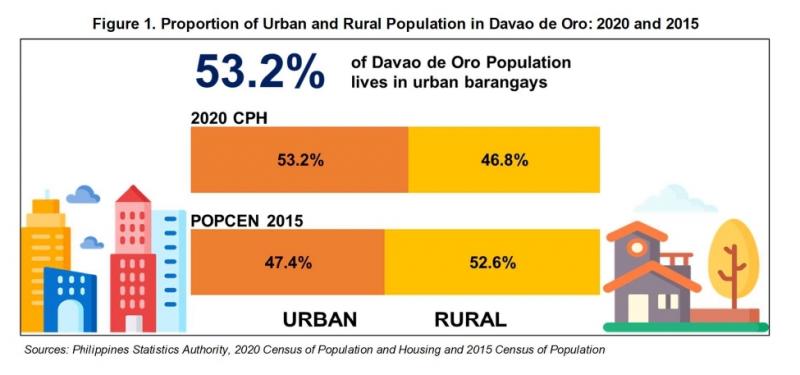
Davao de Oro ranks second in terms of level of urbanization among provinces
Except for City of Davao (91.8%), the only highly urbanized city (HUC) in Davao Region, Davao de Oro (53.2%) ranked second among the five provinces of the region that posted the highest level of urbanization. It is next to Davao del Norte (68.3%), the only province that surpasses the regional level of urbanization in 2020. (Table 1)
On the other hand, Davao Occidental (32.3%) posted the lowest level of urbanization while Davao del Sur (51.8%) and Davao Oriental (41.8%) ranked fourth and fifth. Only Davao del Sur posted a decline in the level of urbanization with -0.2 percentage point decrease in 2020. (Table 1)
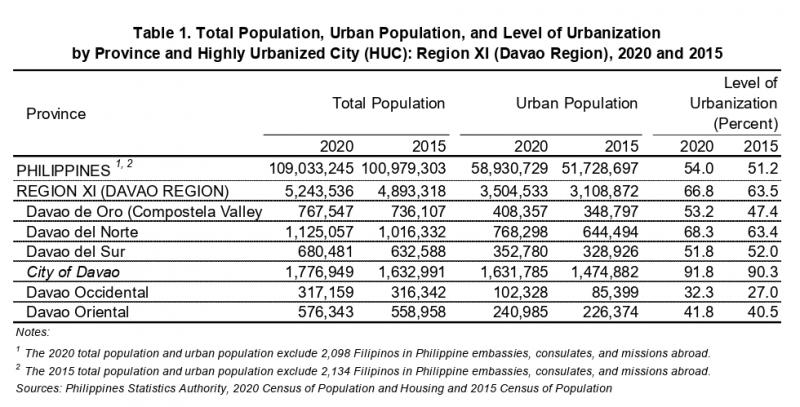
Six municipalities surpass the provincial level of urbanization
Among the 11 municipalities of the province, six of them posted a level of urbanization higher than the provincial level (53.2%). These were: Pantukan (77.1%), Compostela (70.7%), Mabini (66.1%), Monkayo (58.1%), New Bataan (57.4%), and Mawab (54.7%). In 2015, Pantukan (78.0%), Compostela (60.5%), Nabunturan (56.6%), Mabini (56.1%), Monkayo (51.0%), and New Bataan (49.6%) were the municipalities that registered higher than provincial level of urbanization at 47.4%. (Table 2)
On the contrary, Montevista (31.9%), Laak (32.2%), and Maco (38.4%) are the top three municipalities with the lowest level of urbanization. Moreover, the capital municipality of the province, Nabunturan (47.4%), posted a decline of -9.2 percent level of urbanization in 2020. (Table 2)
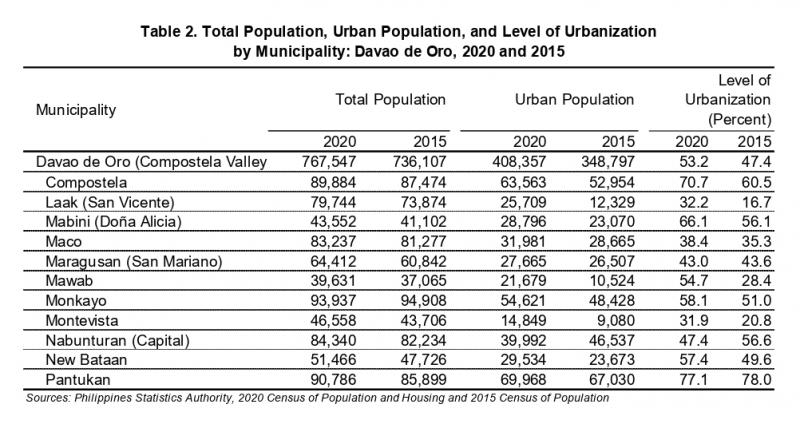
Pantukan, Compostela, and Monkayo among the top ten municipalities with the highest urban population
In terms of population, Davao de Oro have three municipalities who entered the top ten municipalities with the highest population living in urban barangays and these were Pantukan (ranked 7th), Compostela (ranked 8th), and Monkayo (ranked 10th). (Table 3)
Nevertheless, Davao del Norte also have three municipalities in the top ten urban population which were City of Tagum (ranked 1st), City of Panabo (ranked 2nd), and Sto. Tomas (ranked 6th). While Davao del Sur have two municipalities in the top ten which were City of Digos (ranked 2nd) and Santa Cruz (ranked 5th). The rest of the top ten municipalities belong to Davao Oriental for City of Mati (ranked 4th) and Davao Occidental for Malita (ranked 9th). (Table 3)
Among the top ten municipalities who have the highest urban population, all except Malita (46.6%) and Monkayo (58.1%) posted higher level of urbanization compared to regional level (66.8%). But comparing to their provincial level, these municipalities posted higher level of urbanization. (Table 3)
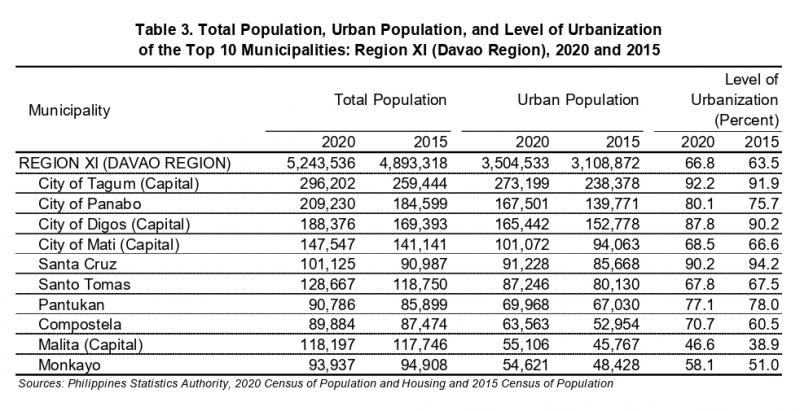
Pantukan and Compostela are among the 11 highly urbanized city and municipalities with a level of urbanization above regional level
Including City of Davao, ten municipalities registered a level of urbanization higher than regional level (66.8%). Two of which belong to Davao de Oro, which were Pantukan (77.1%) and Compostela (70.7%). (Table 4)
In addition, Talaingod (100%), City of Tagum (92.2%), Braulio E. Dujali (88.2%), and Santo Tomas (67.8%) of Davao del Norte together with Santa Cruz (90.2%) and City of Digos (88.2%) of Davao del Sur and City of Mati (68.5%) of Davao Oriental were among the municipalities with above regional level of urbanization. (Table 4)
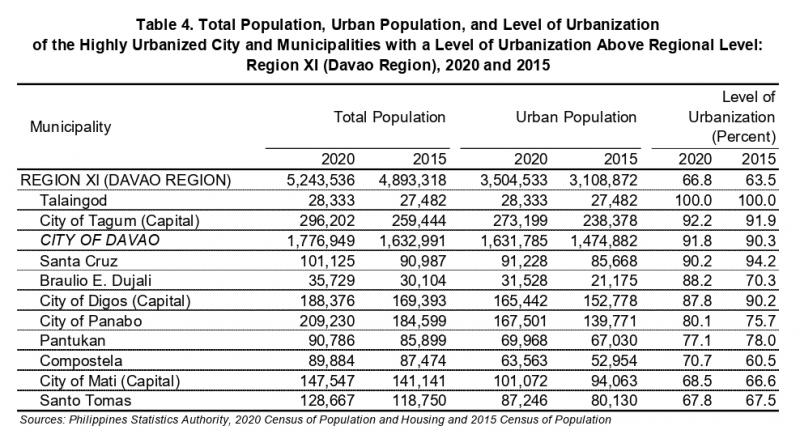
Proportion of urban barangays to total barangays gains by 4.6 percentage points
Out of the 237 barangays in Davao de Oro in 2020, 58 barangays or 24.5 percent were classified urban. In 2015, 47 barangays were classified as urban, representing 19.8 percent of the total barangays during that year. (Table 5)
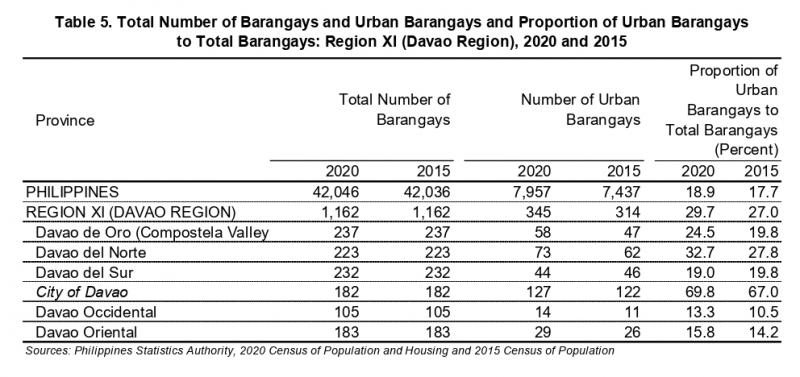
Technical Notes:
Barangay is the smallest political unit in the country. The official list of barangays of the Department of the Interior and Local Government (DILG) based on the Philippine Standard Geographic Code (PSGC) as of 31 December 2020 was used during the 2020 CPH operations. For purposes of this publication, the PSGC as of 31 March 2022 was used as reference, to reflect the new composition of the Bangsamoro Autonomous Region in Muslim Mindanao (BARMM).
Urban barangay is a barangay classified as urban if it meets any of the following:
1. It has a population size of 5,000 or more; or
2. It has at least one establishment with a minimum of 100 employees; or
3. It has five or more establishments with 10 to 99 employees, and five or more facilities within the two-kilometer radius from the barangay hall.
Rural barangay is a barangay classified as rural which done satisfy the abovementioned criteria.
Urban population refers to persons living in urban areas/barangays.
Level of urbanization is the proportion of the urban population to the total population in a specific period. It is calculated by dividing the urban population by the total population and multiplying the quotient by 100.
